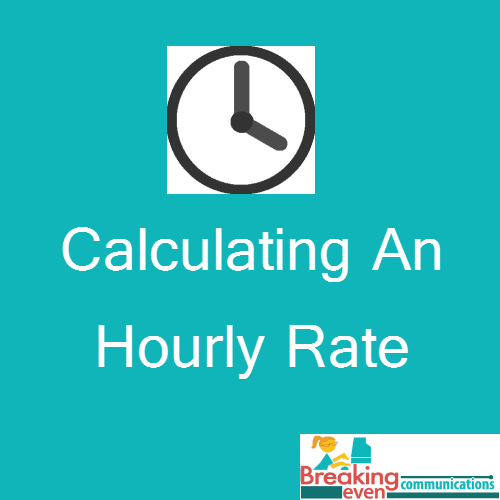People have asked me in the past, “So how do you come up with a rate of $75/hour?”
What I love is when they make this leap: “Wow, you make $75/hour?!? You must be rich!”
If I actually made $75/hour for every hour I worked in a week, that would be lovely wouldn’t it? And technically, I would be rich (though hopefully you’d love me anyway).
For those starting out in a service related business trying to figure out prices or those wondering where the heck we got our hourly rate number, here is the logic and the math which will work for you whether you design websites or walk dogs:
Factor 1: The Concept Of Billable Hours
While I wish someone would pay me to watch reality television while wearing my pajamas and eating Lucky Charms, it is not the case. I have to actually do something to get paid. (And if you are sitting at your job getting paid to have your butt in a chair right now and read this blog, please appreciate that!)
The single most important thing I took away from the one business class I’ve ever taken was the concept of billable hours.
Billable hours happen when you are actually doing work. For me updating or fixing someone’s website, writing up the social media posts or newsletter, or doing some other thing people pay us to do.
What are non-billable hours? Writing this blog. Spending an hour on the phone with GoDaddy trying to get them to change the contact email on your domain. Writing emails telling you about the progress of your project. Filing the 150 pictures you just emailed me digitally so we can access it later. Networking the printer. Cleaning the office bathroom. Writing proposals for prospective work. Invoicing. Answering peoples’ questions about the invoices. Organizing workshops.
As you see, for most people the non-billable hours are not only necessary but they take up a majority of work time. Sadly these are not something you can make your clients pay for (though if one of you wanted to pay me to clean our fridge it would probably happen more often.)
My goal is to have 10 billable hours a week and for Alice to have 5. And as the business gets more established and I can spend more time doing work (instead of asking for it), this number should go up. But when you are starting out, billable hours are usually very low.
One month, when I was just starting out, I had 4 billable hours. For the entire month. Gulp. (Hint: Have savings for these sort of things.)
So when you figure out your hourly rate, think about realistically how many hours of paid work you expect to get then divide that into your living expenses:
$1500 for one month living expenses / 10 hours of expected billable hours in a month = $150/hour
Factor 2: Market Rate
Now I know multiple other people who live in San Francisco, New York, and Boston respectively who all charge $150/hour for the same work I do. So why do I charge $75?
In addition to looking at the average salary of what people in my profession make, I also have to look at what people in the area I plan to serve are willing to pay. Where I live, I know a high end carpenter who charges $75/hour and a plumber that charges $90/hour. They are both incredibly busy and have a reputation for being great. While they aren’t in my profession, looking at other professionals in my geographic area gives me an idea of what individuals and businesses in my area pay for services.
I guess by ‘market rate’ I mean you need to look at not only what range is acceptable in your profession but also what the economic reality is for your customers. My city counterparts can make more money because a) where they live is more expensive so they have higher costs and b) the people who live there are willing to pay more money. At some point I will probably raise my hourly rate but for now, I’m comfortable with this.
Factor 3: Pacing Your Projects
Much of your work isn’t going to be hourly work but project work. So instead of ‘fix this problem on my website that you said will take you two hours’, it’ll be ‘design my website please.’
Knowing how long it’ll take you to do a project will not only keep you sane, it’ll also help you price the projects you do.
So with us I know:
1) We can launch 1 website/month while doing our normal hourly stuff that sporadically comes in.
2) With having an intern helping part time in the summer, we can handle maintaining social media accounts for 10 businesses during the peak season in our area (May-October).
Keeping the right amount of projects spaced out also means we don’t have to rely so heavily on billable hours which can be sporadic.
As you do your work, whether it’s cutting hair or building greenhouses, you’ll figure out what you can handle in a month in terms of regular and non-regular work which will give you an even better idea of what you should charge.
Whatever you do, don’t set your rate too low at first. It is very easy to lower prices but very hard to raise them.
So set that hourly rate carefully… because it’ll be a part of your business life daily. And when people question your rate, you’ll be ready with a thoughtful and very business savvy answer.

